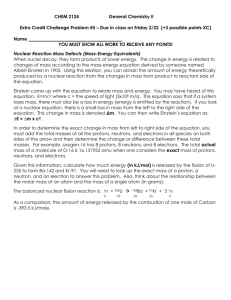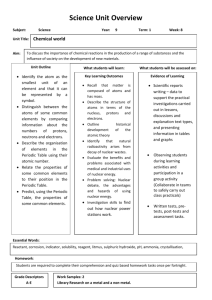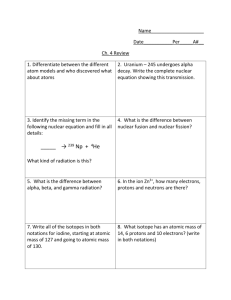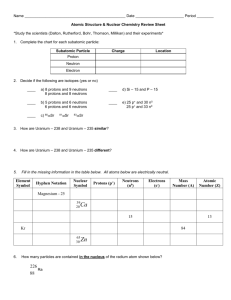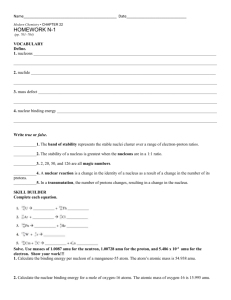Chapter_19_Nuclear_Chemistry
advertisement
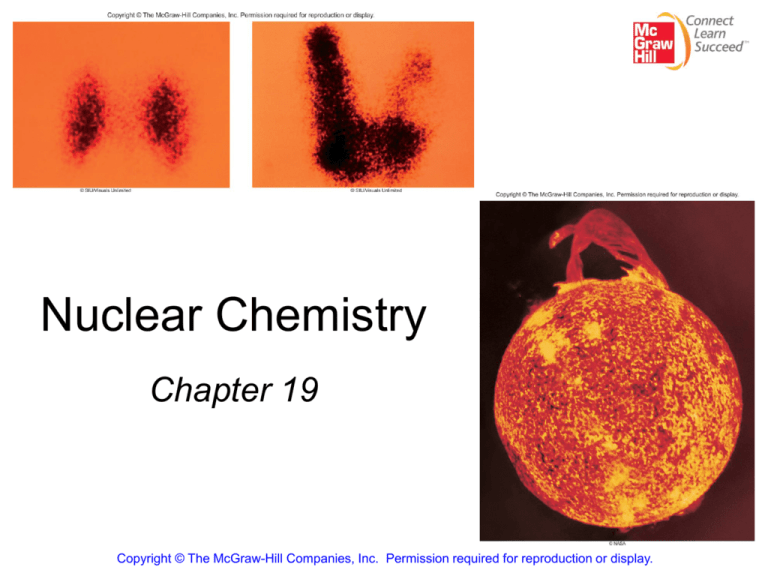
Nuclear Chemistry Chapter 19 1 Copyright © The McGraw-Hill Companies, Inc. Permission required for reproduction or display. Review Atomic number (Z) = number of protons in nucleus Mass number (A) = number of protons + number of neutrons = atomic number (Z) + number of neutrons Mass Number Atomic Number A ZX Element Symbol proton 1p 1H or 1 1 neutron 1n 0 electron 0b 0e or -1 -1 positron 0b 0e or +1 +1 a particle 4He 4a or 2 2 A 1 1 0 0 4 Z 1 0 -1 +1 2 2 Balancing Nuclear Equations 1. Conserve mass number (A). The sum of protons plus neutrons in the products must equal the sum of protons plus neutrons in the reactants. 235 92 U + 10n 138 55 Cs + 96 37 Rb + 2 10n 235 + 1 = 138 + 96 + 2x1 2. Conserve atomic number (Z) or nuclear charge. The sum of nuclear charges in the products must equal the sum of nuclear charges in the reactants. 235 92 U + 10n 138 55 Cs + 96 37 Rb 92 + 0 = 55 + 37 + 2x0 + 2 10n 3 4 Example 19.1 Balance the following nuclear equations (that is, identify the product X): (a) 212 Po (b) 137 Cs 84 55 208 82 Pb +X 137 56 Ba +X 5 Example 19.1 Strategy In balancing nuclear equations, note that the sum of atomic numbers and that of mass numbers must match on both sides of the equation. Solution (a) The mass number and atomic number are 212 and 84, respectively, on the left-hand side and 208 and 82, respectively, on the right-hand side. Thus, X must have a mass number of 4 and an atomic number of 2, which means that it is an α particle. The balanced equation is 212 84 Po 208 82 Pb + 4 2a 6 Example 19.1 (b) In this case, the mass number is the same on both sides of the equation, but the atomic number of the product is 1 more than that of the reactant. Thus, X must have a mass number of 0 and an atomic number of -1, which means that it is a β particle. The only way this change can come about is to have a neutron in the Cs nucleus transformed into a proton and an electron; that is, 01 n 11 p + -10 Β (note that this process does not alter the mass number). Thus, the balanced equation is 137 55 Cs 137 56 Ba + 0 -1 Β 7 Example 19.1 Check Note that the equation in (a) and (b) are balanced for nuclear particles but not for electrical charges. To balance the charges, we would need to add two electrons on the right-hand side of (a) and express barium as a cation (Ba+) in (b). 8 Nuclear Stability • Certain numbers of neutrons and protons are extra stable − n or p = 2, 8, 20, 50, 82 and 126 − Like extra stable numbers of electrons in noble gases (e- = 2, 10, 18, 36, 54 and 86) • Nuclei with even numbers of both protons and neutrons are more stable than those with odd numbers of neutrons and protons • All isotopes of the elements with atomic numbers higher than 83 are radioactive • All isotopes of Tc and Pm are radioactive 9 10 n/p too large beta decay X Y n/p too small positron decay or electron capture 11 Nuclear Stability and Radioactive Decay Beta decay 14C 6 14N 7 40K 19 +-10b 40Ca 20 Decrease # of neutrons by 1 + -10b 1n 0 Increase # of protons by 1 1p 1 + -10b Positron decay ++10b 11C 6 11B 5 38 19K 38Ar 18 Increase # of neutrons by 1 ++10b 1p 1 Decrease # of protons by 1 1n 0 ++10b 12 Nuclear Stability and Radioactive Decay Electron capture decay 37 18 Ar + -10e 37Cl 17 55Fe 26 +-10e 55Mn 25 1 1p Increase number of neutrons by 1 Decrease number of protons by 1 + -10e 1n 0 Alpha decay Decrease number of neutrons by 2 212Po 84 4He 2 + 208 82Pb Decrease number of protons by 2 Spontaneous fission 252Cf 98 1n 2125 In + 2 49 0 13 Nuclear binding energy is the energy required to break up a nucleus into its component protons and neutrons. Nuclear binding energy + 199 F 911p + 1010n DE = (Dm)c2 9 x (p mass) + 10 x (n mass) = 19.15708 amu Dm= 18.9984 amu – 19.15708 amu Dm = -0.1587 amu DE = -0.1587 amu x (3.00 x 108 m/s)2= -1.43 x 1016 amu m2/s2 Using conversion factors: 1 kg = 6.022 x 1026 amu 1 J = kg m2/s2 DE = -2.37 x 10-11J 14 DE = (-2.37 x 10-11J) x (6.022 x 1023/mol) DE = -1.43 x 1013J/mol DE = -1.43 x 1010kJ/mol Nuclear binding energy = 1.43 x 1010kJ/mol binding energy binding energy per nucleon = number of nucleons 2.37 x 10-11 J = 19 nucleons = 1.25 x 10-12 J/nucleon 15 Nuclear binding energy per nucleon vs mass number nuclear binding energy nucleon nuclear stability 16 Example 19.2 127 53 I The atomic mass of is 126.9004 amu. Calculate the nuclear binding energy of this nucleus and the corresponding nuclear binding energy per nucleon. 17 Example 19.2 Strategy To calculate the nuclear binding energy, we first determine the difference between the mass of the nucleus and the mass of all the protons and neutrons, which gives us the mass defect. Next, we apply Equation (19.2) [ΔE = (Δm)c2]. Solution There are 53 protons and 74 neutrons in the iodine nucleus. 1 The mass of 53 1H atom is 53 x 1.007825 amu = 53.41473 amu and the mass of 74 neutrons is 74 x 1.008665 amu = 74.64121 amu 18 Example 19.2 127 53 I Therefore, the predicted mass for is 53.41473 + 74.64121 = 128.05594 amu, and the mass defect is Δm = 126.9004 amu - 128.05594 amu = -1.1555 amu The energy released is ΔE = (Δm)c2 = (-1.1555 amu) (3.00 x 108 m/s)2 = -1.04 x 1017 amu · m2/s2 19 Example 19.2 Let’s convert to a more familiar energy unit of joules. Recall that 1 J = 1 kg · m2/s2. Therefore, we need to convert amu to kg: 2 amu m 1.00 g 1 kg 17 DE -1.04×10 × × 2 23 s 6.022×10 amu 1000 g = -1.73×10-10 kg m 2 -10 = -1.73×10 J 2 s Thus, the nuclear binding energy is 1.73 x 10-10 J . The nuclear binding energy per nucleon is obtained as follows: 1.73×10-10 J = = 1.36 ×10-12 J / nucleon 127 nucleons 20 Kinetics of Radioactive Decay N daughter rate = lN Nt = -lt ln N0 N = the number of atoms at time t N0 = the number of atoms at time t = 0 l is the decay constant t½ 0.693 = l 21 22 Radiocarbon Dating 14N 7 + 01n 14C 6 14C 6 14N 7 + 11H + -10b + n t½ = 5730 years Uranium-238 Dating 238U 92 206Pb 82 + 8 24a + 6-10b t½ = 4.51 x 109 years 23 Nuclear Transmutation 14N 7 27Al 13 14N 7 + 24a + 24a + 11p 17O 8 + 11p 30P 15 + 01n 11C 6 + 42a 24 Example 19.3 Write the balanced equation for the nuclear reaction 56 54 Fe(d,α) 26 25 Mn where d represents the deuterium nucleus (that is, 21H ). 25 Example 19.3 Strategy To write the balanced nuclear equation, remember that the first 54 56 isotope 26 Fe is the reactant and the second isotope 25 Mn is the product. The first symbol in parentheses (d) is the bombarding particle and the second symbol in parentheses (α) is the particle emitted as a result of nuclear transmutation. 26 Example 19.3 Solution The abbreviation tells us that when iron-56 is bombarded with a deuterium nucleus, it produces the manganese-54 nucleus plus an α particle. Thus, the equation for this reaction is 56 26 Fe + 2 1H 4 2α + 54 25 Mn Check Make sure that the sum of mass numbers and the sum of atomic numbers are the same on both sides of the equation. 27 Nuclear Transmutation 28 Nuclear Fission 235U 92 + 01n 90Sr 38 1n + Energy + 143 Xe + 3 0 54 Energy = [mass 235U + mass n – (mass 90Sr + mass 143Xe + 3 x mass n )] x c2 Energy = 3.3 x 10-11J per 235U = 2.0 x 1013 J per mole 235U Combustion of 1 ton of coal = 5 x 107 J 29 Nuclear Fission Representative fission reaction 235U 92 + 01n 90Sr 38 1n + Energy + 143 Xe + 3 0 54 30 31 Nuclear Fission Nuclear chain reaction is a self-sustaining sequence of nuclear fission reactions. The minimum mass of fissionable material required to generate a self-sustaining nuclear chain reaction is the critical mass. 32 Schematic of an Atomic Bomb 33 Schematic Diagram of a Nuclear Reactor refueling 34 U3O8 Chemistry In Action: Nature’s Own Fission Reactor Natural Uranium 0.7202 % U-235 99.2798% U-238 Measured at Oklo 0.7171 % U-235 35 Nuclear Fusion Fusion Reaction 2 2 3 1 1 H + 1H 1 H + 1H 2H 1 + 13H 6Li 3 + 12H 4He 2 2 + 10n 4He 2 Energy Released 4.9 x 10-13 J 2.8 x 10-12 J 3.6 x 10-12 J solar fusion Tokamak magnetic plasma confinement 36 normal enlarged Thyroid images with 125I-labeled compound 37 Radioisotopes in Medicine Research production of 99Mo 98Mo 42 + 10n Bone Scan with 99mTc 99Mo 42 Commercial production of 99Mo 235U 92 99Mo 42 99mTc 43 + 10n 99Mo 42 + -10b t½ = 66 hours + g-ray t½ = 6 hours 99mTc 43 99Tc 43 + other fission products 38 Geiger-Müller Counter 39 Biological Effects of Radiation Radiation absorbed dose (rad) 1 rad = 1 x 10-5 J/g of material Roentgen equivalent for man (rem) 1 rem = 1 rad x Q Quality Factor g-ray = 1 b=1 a = 20 40 Chemistry In Action: Food Irradiation 41
